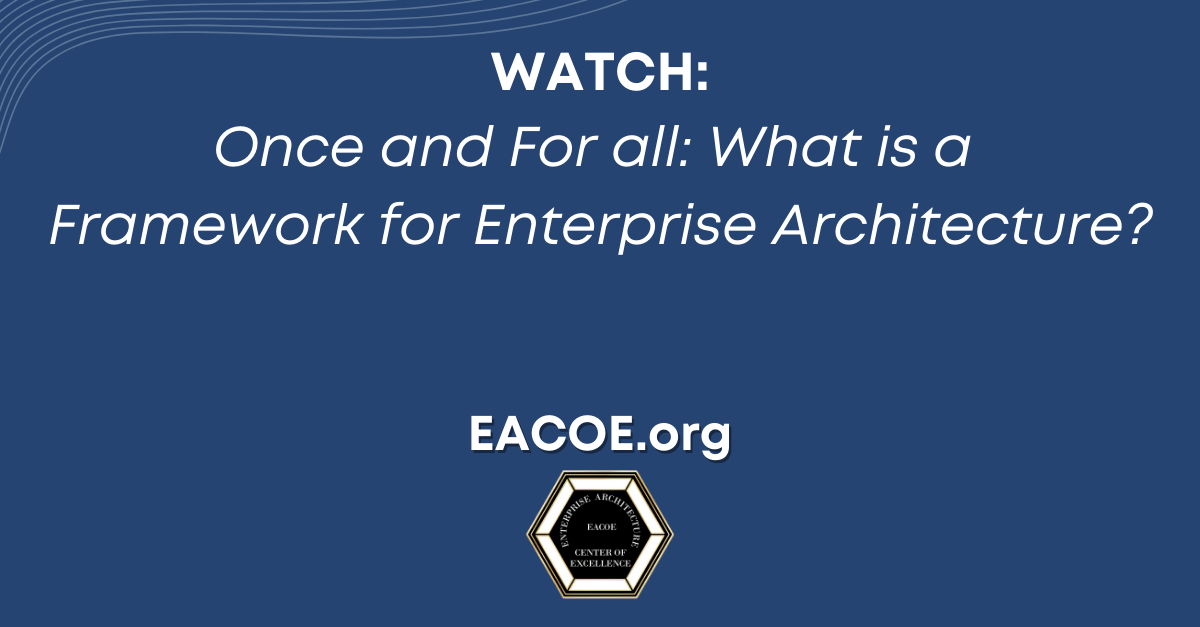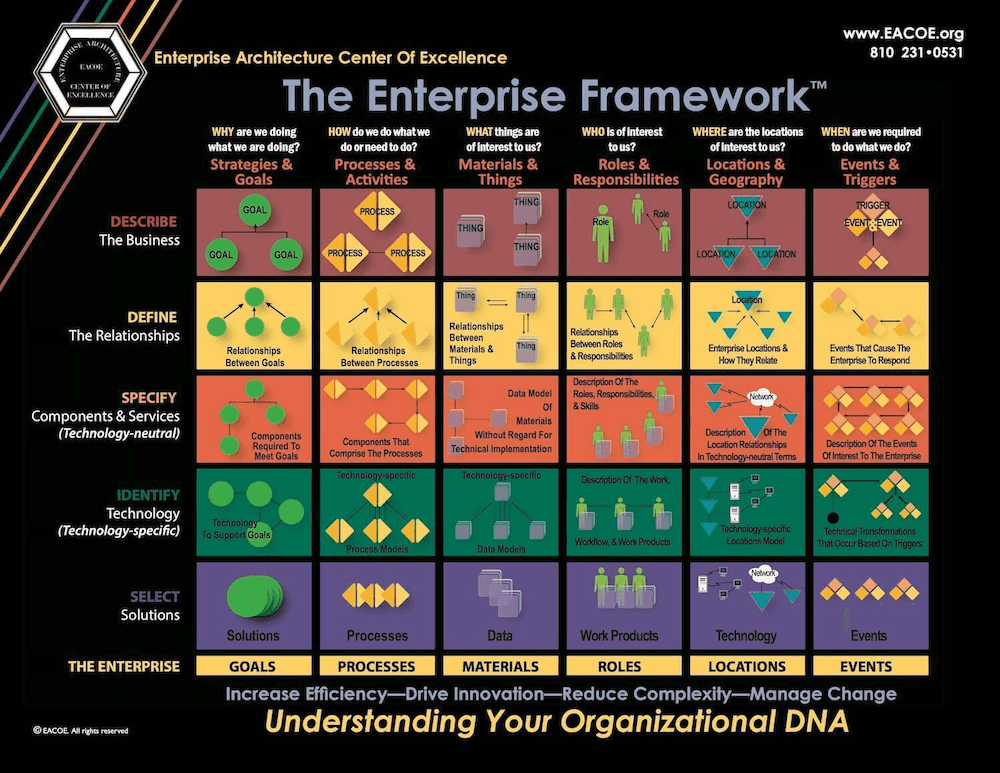Understanding Frameworks for Enterprise Architecture
There are many misunderstood words and confusing phrases in the Enterprise Architecture discipline due to irregularity between academia, publications, consultants, and the internet.
Below are fact-based descriptions grounded on logic, sound practices, and principles based on decades of field engagements and experience. We hope our credentials are meaningful to you and will provide some sanity to this confusion.
One very misunderstood word is “framework.” Another phrase that may be more useful is a frame of reference.
A framework is a structure that organizes a set of related artifacts. It shows the relationships among the artifacts of a chosen subject area and brings a totality perspective to otherwise individual ideas.
A framework, therefore, makes the unorganized organized, and coherent.
It is simply a thinking tool. And as a thinking tool, a "true" framework will never have an "output."
Frames of reference are fundamental to any profession or discipline (engineering, chemistry, physics, linguistics, music—anything)
Framework elements must be mutually exclusive and collectively exhaustive. A framework that is in constant update and versioning is troubling. If it is, it is not (or was not) complete.
If we are using Version 4 of a so-called "framework" and now a new Version 9 has been released…. What does that say about the work we did with Version 4?
Can you imagine the English alphabet starting with fifteen letters (Version 1), then going to twenty-one (Version 2), and then twenty- six (version 3), with more proposed arrangements yet to come? How useful would that be?
Can you imagine the periodic table of chemical elements having multiple versions? Chemistry would be alchemy. Can you imagine the notes of music being in continuous versioning? (It would be enjoyable to play in an orchestra.)
Once and for all, what is a Framework for Enterprise Architecture?
Why does enterprise architecture need one frame of reference (a Framework)?
Organizations are adding complexity by mapping different frameworks, languages, and notations to an environment that is already too complex to understand. As human beings, we are naturally "visually" oriented. We cannot "see" the essence of a problem or solution in 400 pages of text. What pages and pages of text on a company’s performance cannot achieve, Enterprise Architecture can, with its visual and graphic impact.
In order to have a profession, there needs to be, there has to be one frame of reference. You can't roll your own, and you can't have multiple frames of references that are there. A proper framework for enterprise architects should outline a structure representing the complex interactions between business, information, people, processes, and technology.
Enterprise Architecture frameworks and strategic planning are the keys to planning, coordinating, and implementing an organization's business objectives. Enterprise Architecture (EA) is developed based on goals and overall business objectives. They help the smooth functioning of different organizational units, both inside and outside the information systems architecture.
Enterprise Architecture frameworks can also organize architecture into different "views" and "transformations" that make sense to various stakeholders. Thus, views are the other complementary projections of the enterprise model.
For an organization desirous of developing an Enterprise Architecture, there are various self-described frameworks to choose. Depending on the complexity and scale of the enterprise, they can select from commercial, defense industry, and government frameworks.
Frameworks such as DODAF, MODAF, and TOGAF are classified as Implementation Frameworks and/or methodologies in combination with a framework. DODAF, MODAF, and TOGAF's so-called "frameworks" are continuously modified and altered. If you were using Version 8.9 of the framework and we now have Version 10, what does that say about the foundation and knowledge we got from Version 8.9?
You may find the article "Comparing Two Leading Enterprise Architecture Methodologies And Frameworks: TOGAF And EACOE" of interest - read it here.
Architecture Framework vs. Architecture Methodology
A framework is not a methodology, and a methodology is not a framework. A framework can possibly accommodate many methods, but there is no proven methodology that works across multiple frameworks (at least not in the practitioner's world).
A methodology is a set of practices and procedures applied to a specific branch of knowledge. A methodology contains proven processes to follow in planning, defining, analyzing, designing, building, testing, and implementing the area under consideration.
An outstanding methodology simplifies and standardizes the process; it can be customized to meet an organization's specific standards and practices.
An outstanding methodology is correct, up-to-date, complete, and concise; it defines deliverables; it has methods, techniques, standards, practices, roles, and responsibilities; it has suggested timings and sequences and dependencies; and it has associated education.
Guidelines or principles are not methodologies either. A guideline might tell you what operations you can do or provide suggestions on deliverables. Methodologies should provide a predefined path or paths – a "roadmap" or a "recipe."
A methodology should allow you to do something "Monday morning"—you shouldn't have to figure out how to take a guideline and turn it into a path. How can a beginning practitioner be expected to "modify" or "customize" a methodology if they have not actually done Architecture?
Frameworks for enterprise architects - a frame of reference
To make explicit representations easier to understand, the organization should work with a consistent set of diagrams and symbols that everyone understands.
The EACOE Enterprise Framework™ defines how to organize the structures and components within an architecture. Business Leaders and architects may use the framework to describe an organization's current, future, and gap analysis states. The EACOE Enterprise Framework is not just "enterprise architecture" – it describes the twelve fundamental architectures in an enterprise.
To complement The Enterprise Framework™, the Enterprise Architecture Center Of Excellence (EACOE) Enterprise Architecture Methodology includes a standard set of skills, practices, definitions, templates, and tools for each step in the process of developing an Enterprise Architecture based on The Enterprise Framework™.
The Methodology demystifies the process of designing the architecture of the enterprise. It provides a step-by-step approach to Enterprise Architecture, ensuring the organization meets the goals and objectives established by management. The Methodology enables organizations to use Enterprise Architecture as a decision-making tool for business strategy, information technology development and alignment, risk analysis, and project and program prioritization.
Based on the work of John Zachman and John Sowa from IBM and elaborations thereof, The Enterprise Framework™ leverages artifacts, diagrams, and abstractions widely recognized by business and technology professionals.
It is important to realize that without these standardized representations, businesses are running off individualized, personal interpretations and networks. Imagine what it would be like if every organization had its own version of the English alphabet—some with sixteen letters, some with twenty-six, and some with a hundred and forty-three! Communication would be impossible. So it is without a Framework that is universal for Enterprise Architecture. There are many ways (methodologies) to use the Framework, but only a single, definite Framework should be used.
The major value of a blueprint, if it is constructed using a universally understood “language,” is that the same meaning is obtained no matter who is interpreting the blueprint. A blueprint’s value is severely limited if the author is the only person who can consistently interpret the representation. Using a Framework that everyone understands is imperative, and using a methodology in common for Enterprise Architecture provides organizational simplification.
The Enterprise FrameworkTM is THE Definitive Framework for Your Enterprise Architecture Activities
Want To Learn More About Enterprise Architecture?
We offer best-in-class Enterprise Architecture workshops by experienced practitioners to help you learn and become certified in Enterprise Architecture.


